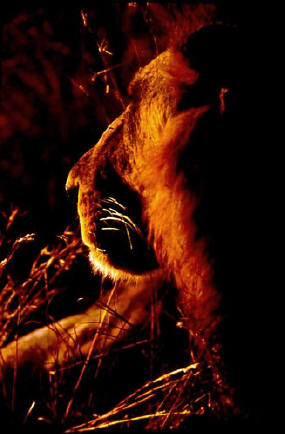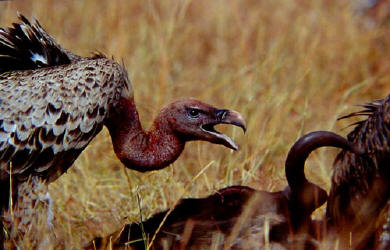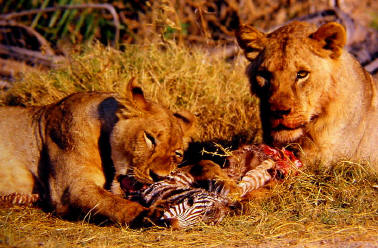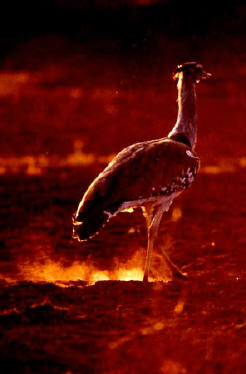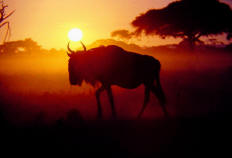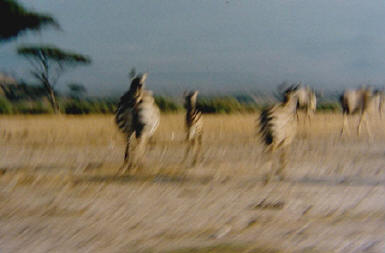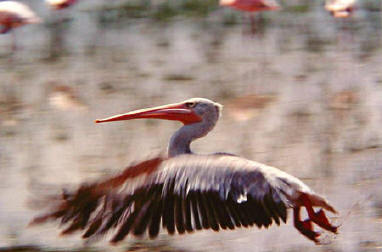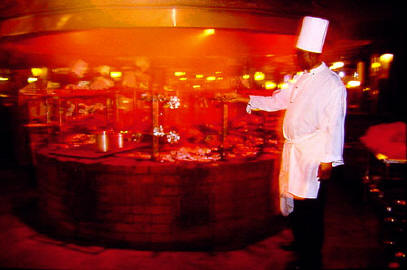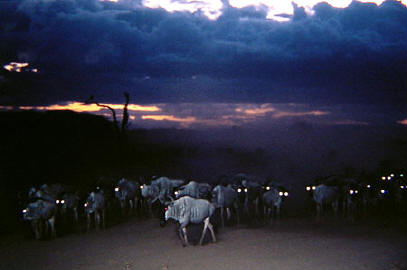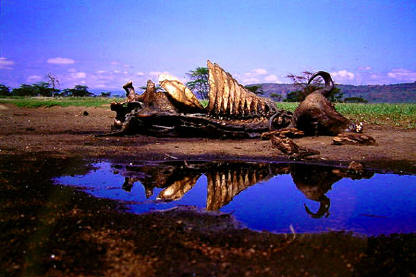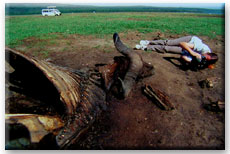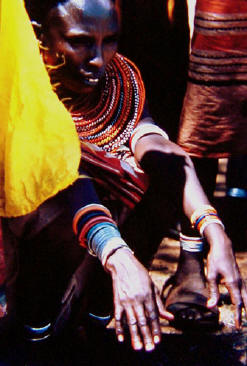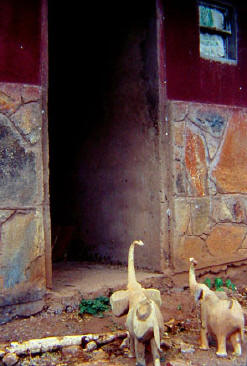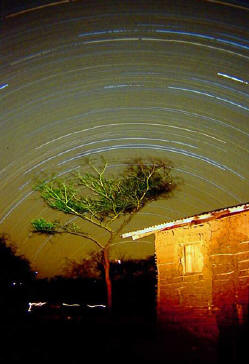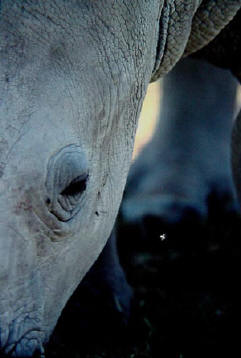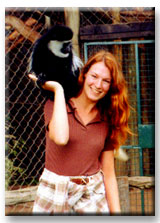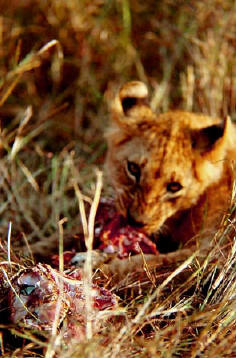|
SAFARI PHOTOS WITH A TWIST by Tina Wright For as long as I can remember, I have had a fascination with the Dark Continent. It’s ancient cultures, curious fauna, and harsh landscapes paint a portrait of an undisturbed world still immersed in primordial isolation. That world became my dream, and I finally came to realize that dream many years ago on my honeymoon to Kenya. The dream has since become an obsession, as I make repeated visits over the years. Each trip typically encompasses a three to four week time period in which I traverse the country from north to south. I spend my time visiting the national parks and the semi-nomadic, pastoralist tribes that populate their boundaries. I carry with me roughly 200 rolls of color slide film, with ISO ratings ranging from 50 to 1600. Few clothes accompany me as I reserve that space for a ridiculous amount of camera gear.
Through my visits I have come to love and respect all that Kenya embodies, and I strive to capture those emotions on film, though the results of my first trip proved somewhat disappointing. Their downfall came with my fear of experimentation – my fear of wasting film! The photographs were nice, but I sought more than a simple rendering of the subjects. I sought a collection of images that, through creativity and artistry, would speak without words! Since then I have made it my mission to hold nothing back – to look at Kenya with the curiosity of a child. In doing so I feel that I am able to capture, both through my lens and my mind, that undisturbed world that lures me back time and again. The Twist In order to find the unusual images I seek, I have to approach my subjects with an open mind, looking beyond the obvious to the obscure. Taking risks and an unconventional approach to my photography is often necessary. My technical knowledge is repeatedly tested, and the constant thinking, trying to create something new and fresh with every frame, can at times be incredibly tiring. Despite these moments, the results far outweigh the difficulties and besides, there is nothing like the rush of exhilaration that comes with a great shoot. Unique Compositions and Viewpoints When I first approach a subject I always search for a unique angle, composition, or viewpoint to work with. This sometimes means, "breaking the rules" of photography. I often crop off extremities if a portion of an animal, such as its horns or its gaze, stands to be enhanced by that exclusion. I love to turn the horizon on a diagonal. This does not work for every image, but when it does the end product is one of dynamic impact. Another consideration is viewpoint. When I first began to photograph Kenya’s wildlife, I noticed that frequently, just as I was ready to snap their lovely mugs, they would turn tail and show me their backsides. Making the best of a bad situation, I took the shots anyway and was pleasantly surprised by the results. Simplicity Photographs that are simplistic in their content are often some of my favorites. By simple, I mean getting down to the heart of an image by eliminating everything else. A deep blue and crimson sky at sunset; a solitary pelican swimming across a tranquil lake during an afternoon shower – these can be powerful moments for both the photographer and the viewer. Backlight I favor backlight when the opportunity arises, whether it’s a rim effect, creating a halo of light around the subject, or a solid silhouette. The trick is proper exposure. For rim light, I take a spot reading from my handheld meter. I choose an area that includes the brightest highlight and the darkest shadow in which I wish to retain detail, split them in half in the viewfinder, and obtain the exposure. For silhouettes I take a reading from the brightest area of the sky excluding the sun, as its inclusion will underexpose the image. When in doubt bracket the exposure, as this should ensure a perfect frame every time.Grainy Films I frequently use films of ISO 400 and above to compliment certain lighting conditions. Kenya is a dusty place, and at dusk when the animals are on the move to reach their nightly havens, I find that these films greatly enhance the overall mood. Although the larger grain structures, or sand-like particles, of these high speed emulsions are not always desired, they often mix with the muted blue hues of the day’s end to produce ethereal qualities which boarder on the sublime. Blur Kenya provides the quintessential location for the use of blur, as it is a stage of constant movement. Shutter speeds dictate motion, with fast ones of 1/250 second and above freezing action, and slow ones of 1/30 second and below blurring action. I use several techniques to achieve blur depending upon the desired results. Panning illustrates the dynamic qualities of fast-moving creatures by rendering a focused subject against a blurred background. Setting the camera at 1/30 second or less, I depress the shutter and pan smoothly with the subject until the shutter closes. On the other hand, keeping the camera steady while using a shutter speed of 1/15 second or less will signify a passage in time. This is expressed by streaking the moving object against its stationary surroundings. Another effect that I find pleasing is a blurred subject against a blurred background, which results from moving the camera with a short, jerking motion while using a slow shutter speed. This perpetuates a feeling of fear or aggression, as in the case of a herd of zebras fleeing a predator or a charging elephant defending it’s young. Flash I thoroughly enjoy mixing artificial and ambient (available) light. This type of imagery seems to accentuate the air of mystery and intrigue that Africa possesses. I habitually use my flash unit during sunrise and sunset. In order to maintain detail and color in the background I take a meter reading of the ambient light and dial it into the flash. For example – if the meter reads 1/60 second at f/4, I then set the camera for that reading and set the flash on full power at f/4. This works particularly well on a herd of animals to create a "headlight" effect due to eyeshine. Another approach that works nicely both indoors and out, is dragging the shutter. The same metering method applies, but a shutter speed of 1/30 second or slower must be used - the slower the better. The quick burst of light freezes the subject but the long exposure far outlast that burst, allowing any movement thereafter to record as blur. I recently used this method at a popular restaurant in Kenya’s capital city of Nairobi, aptly named "The Carnivore". I wanted to capture the fantastic ambiance that attacks the senses of it’s patrons as they walk through the door, instantly fixing their gaze on the center of the establishment where a large, brick smoke pit containing huge spits of roasting game meats rest. By dragging the shutter, I allowed the red lights in the pit to bleed through, thereby trapping that atmosphere on film. Super Wide Angles Although I make good use of my 500mm lens on safari, I have also found a lot of uses for my 17-35mm zoom lens – and not just with people. By zooming out to 17mm and using it as a super wide-angle lens, I am able to add a whole new element to my photography, providing a visual quality that is impossible to achieve in any other manner. It allows me to stretch boundaries and bring my subjects up close and personal – and besides, it’s just plain fun to use! The Dearly Departed As morbid as it may sound I never overlook a dead animal. In fact I often become a bit over-enthusiastic when finding one, leaving my guide to strongly question my mental stability. The reality is, if you are going to document the day to day life of Kenya, death is merely a cycle of that life. In order to capture a deceased animal on film in an artistic and sensitive manner, it is sometimes necessary to get "down and dirty". I once led a group of photographers with me on safari, and upon encountering a very photogenic buffalo carcass, I found it amusing that despite everybody’s eagerness to shoot it, no one was willing to lie on the ground to take the best vantagepoint. Don’t be afraid of lying on the ground in Africa – it’s just a ground like any other ground – it will not hurt you and neither will the odor. If the stench is bad, move downwind or hold your breath. The results are worth enduring a little discomfort. Tell the Whole Story Kenya is a feast for the eyes, and I shoot anything of interest no matter how insignificant it may seem. I figure, if it caught my eye it must be worth recording. A lot of time is spent driving from park to park, and I use this time to record the daily lives of Kenya’s people. Remember to first ask permission if taking a photograph of any indigenous peoples as some still hold the belief that a picture will steal their soul. Conclusion Each time I leave Kenya I take with me more knowledge of the photographic medium, but more importantly, I take with me more knowledge of this country’s irreplaceable cultures and fauna and the destructive pressures they face. In spite of these advancing pressures, East Africa still remains trapped somewhere far in the past – a world untouched and all its own. Enjoy discovering the dream!
|

